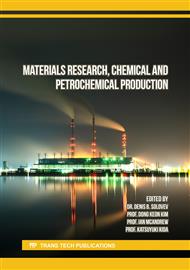p.3
p.11
p.19
p.27
p.35
p.41
p.49
p.59
Preparation and Characterization of Natural Rubber Foam Filled with Bagasse Fiber
Abstract:
The properties of natural rubber foam filled with bagasse fiber of varying content (0-50 phr) and different blowing agent content (5 and 8 phr) were investigated, with rubber compounds and vulcanized rubber also examined. Rubber compound properties included measurements of scorch time, cure time, minimum torque, maximum torque, density, and percentage of expansion in the mold. When bagasse fiber and blowing agent content increased, the maximum torque value of the compounded rubber increased. For rubber compound with blowing agent loading at 5 phr, cure time increased with an increasing bagasse fiber content of 40-50 phr, while scorch time and density of the rubber compound remained unchanged. The percentage of rubber compound expansion in the mold decreased with increasing bagasse fiber content. The cell size of natural rubber foams was inspected using an optical microscope. Small and homogeneous cell size was found in natural rubber foam with blowing agent content of 8 phr and higher bagasse fiber content. The incorporation of bagasse fiber enhanced the compressive strength of the natural rubber foam. Vulcanized rubber properties such as the modulus at 100% strain, tensile strength, and strain at break were also studied. The modulus increased, whereas stress at break and strain at break decreased with increasing bagasse fiber content. On the other hand, tensile strength and strain at break increased with increasing blowing agent loading.
Info:
Periodical:
Pages:
19-25
Citation:
Online since:
April 2023
Keywords:
Price:
Сopyright:
© 2023 Trans Tech Publications Ltd. All Rights Reserved
Share:
Citation:



